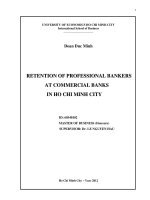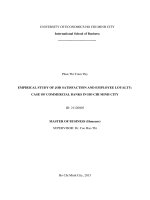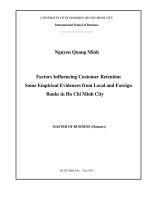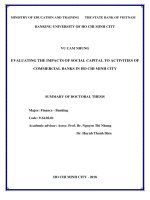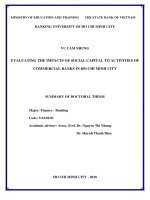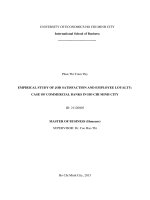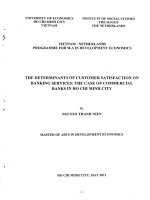The determinants of customer satisfaction on banking services , the case of commercial banks in ho chi minh city
Bạn đang xem bản rút gọn của tài liệu. Xem và tải ngay bản đầy đủ của tài liệu tại đây (504.31 KB, 139 trang )
VIETNAM- NETHERLANDS
PROGRAMME FOR M.A IN DEVELOPMENT ECONOMICS
THE DETERMINANTS OF CUSTOMER SATISFACTION ON
BANKING SERVICES: THE CASE OF COMMERCIAL BANKS
IN HO CHI MINH CITY
By
NGUYEN THANH NIEN
MASTER OF ARTS IN DEVELOPMENT ECONOMICS
HO CHI MINH CITY, MAY 2011
-1-
VIETNAM- NETHERLANDS
PROGRAMME FOR M.A IN DEVELOPMENT ECONOMICS
THE DETERMINANTS OF CUSTOMER SATISFACTION ON
BANKING SERVICES: THE CASE OF COMMERCIAL
BANKS IN HO CHI MINH CITY
A thesis submitted in partial fulfillment of the requirements for the degree of
MASTER OF ARTS IN DEVELOPMENT ECONOMICS
By
NGUYEN THANH NIEN
Academic Supervisor:
Dr. CAO HAO THI
HO CHI MINH CITY, MAY 2011
- 11-
CERTIFICATION
"I certify that the substance of this thesis has not already been submitted for any degree
and has not been currently submitted for any other degree. And to the best of my
knowledge and belief it does not contain any material previously published or written by
another person except where due reference is made in this thesis".
Ho Chi Minh City, May 2011
NGUYEN THANH NIEN
-
·~-
-111-
ACKNOWLEDGEMENT .
I would like to express my gratitude to all people who gave me the support to
complete this thesis.
First, I would like to show my sincere and deep gratitude to my supervisor, Dr. Cao
•
Hao Thi who gave me valuable guidance, comments, advice for the success of my
thesis.
Second, I would like to thank to all lecturers and staffs of the Vietnam- Netherlands
Programme.
Third, I also send my gratefulness to my colleagues in the Department of Individual
Customer Relationship, Bank for Investment and Development of Vietnam Transaction Center 2 Branch for their supports during my study.
Especially, many thanks are respectfully sent to my parents for motivating me to
I
complete the thesis.
....
Finally, I give my special thanks to my wife who is always supporting me to finish
this re~earch.
-IV-
ABSTRACT
Nowadays as globalization and liberalization of financial institutions accelerate,
competition among banks becomes more intense. Therefore, in order to face with
..
, that fierce competition, commercial banks in Vietnam in general and Ho Chi Minh
City in particular always strive to improve access through expansion of Automatic
Teller Machines (ATMs) and branch network; introduce new features for both deposit
and loan products at attractive rate; and develop new electronic banking facilities like
telephone banking, home banking, SMS banking and Internet banking.
However, in reality, there are so many complaints of customers related to the products
and services of banks. Those show the dissatisfaction of customers, lead to losing
customers and cause negative effect on the market share and the profitability of
commercial banks.
The purposes of this research are to determine the main factors affecting customer
satisfaction on banking services including basic facilities, convenience, employee
competence, the environment of bank, transaction cost; and the relationship between
these factors and customer satisfaction. The research is carried out by using
questionnaires, designed according to five-point Likert scale. It is based on a survey
of245 customers in Ho Chi Minh City. Data obtained from the customers were used
for conducting reliability, factor and regression analysis through SPSS software.
Research findings show that the most important factors influencing customer
satisfaction on banking services are the environment of bank and employee
competence, convenience and transaction cost.
However, this research still has some limitations. First of all, data collection is
restricted within a few commercial banks in Ho Chi Minh City only. Secondly,
according to the result of survey, majority of respondents are only from 30 to 50 years
old, may be fail to represent for total the actual situation. Finally, this research
determined the basic factors affecting customer satisfaction on banking services, but
there are still lacked of other factors not be identified.
-v-
CHAPTER 1: INTRODUCTION ..............
,.
I
1.1
1.2
1.3
1.4
1.5
CHAPTER 2: LITERATURE REVIEW
2.1
2.2
2.3 Overview of commercial banks
2.4
CHAPTER 3: ANALYTICAL FRAMEWO
3.1
3.2
3.2.1
3.2.2
3.2.2.1
3.2.2.2
3.2.2.3
3.2.3
3.2.4
3.2.4.1
3.2.4.2
3.2.4.3
3.3
3.4
3 .5
3.6
3.7 Assessment of scale's uni-dime
3.8
3.9
3.10
CHAPTER 4: DATA ANALYSIS AND RE
4.1
4.1.1
4.1.2
4.1.3
4.1.4
-VI-
.
1
..
~I
4.1.5
4.2
4.2.1
4.2.2
4.2.3
4.3
4.3.1
4.3.2
4.4
4.4.1
4.4.2
4.4.3
4.5
4.6
The number
The results of pilot survey .........................
Descriptive sta
Results ofthe sc
Factor analysis
4.2.3.1
4.2.3.2
The results of main survey .........................................
Reliability anal
Factor analysis
Hypothesis testing ......................................................
Adjusted measu
Regression mod
Hypotheses tes
Hierarchical regression analysis ................................
Summary ....................................................................
CHAPTER 5: CONCLUSIONS AND RECOMMENDATIONS ......................
5.1
5.1.1
5.1.2
5.2
5.3
Conclusions ................................................................
Main findings .
Managerial i
Recommendations ......................................................
Limitations .................................................................
REFERENCES........................................................................................................
APPENDICES .........................................................................................................
LIST OF FIGURES
Figure 2.1 Capital mobilization status of commercial banks from 2005 to 2009 ..........12
Figure 2.2 Credit operation status of commercial banks from 2004 to 2009..................13
Figure 3.1 Research model.............................................................................................................. 18
Figure 3.2 Research process........................................................................................................... 19
Figure 4.1 Relative frequency of respondents' type of contact........................................... 29
Figure 4.2 Relative frequency of respondents' age group..................................................... 30
Figure 4.3 Relative frequency of respondents' gender........................................................... 31
Figure 4.4 Relative frequency of banks' type of ownership................................................. 32
Figure 4.5 Relative frequency of number of bank's operation year from the
foundation day.............................................................................................................. 33
- Vll-
LIST OF TABLES
Table 2.1 Literature review summary on custome
Table 3.1 Measurement scales .............................
Table 4.1 Frequency of respondents' type of cont
Table 4.2 Frequency of respondents' age group ...
Table 4.3 Frequency of respondents' gender ........
Table 4.4 Frequency ofbanks' type ofownership .
Table 4.5 Frequency of number of bank's operatio
.. ,
Table 4.6 Descriptive statistics
Table 4.7 Summary of the Cronbach's alpha result
Table 4.8 Factor analysis of independent variables
Table 4.9 Factor analysis of customer satisfaction o
Table 4.10 Result of reliability analysis .................
Table 4.11 Factor analysis of independent variable
Table 4.12 Factor analysis of independent variable
Table 4.13 Factor analysis of the customer satisfac
Tabie 4.14 KMO and Bartlett's Test of independen
.... .Table4.15KMOandBartlett'sTestofcustomers
Table 4.16 Adjusted measurement scales ...............
Table 4.17 Model summary ....................................
Table 4.18 ANOVA .................................................
Table 4.19 Result of coefficients .............................
Table 4.20 Summary of hypotheses testing .............
Table 4.21 Determinants of customer satisfaction o
Table 4.22 Hierarchical regression analysis of cus
Table 4.23 Coefficients of independent variables
.."
- Vlll -
ABBREVIATIONS
1
I.
._
Agribank
: Vietnam Bank for Agriculture and Rural Development
BIDV
: Bank for Investment and Development of Vietnam
MHB
: Housing Bank of Mekong Delta
VietinBank
:Vietnam Joint Stock Commercial Bank for Industry and Trade
Vietcombank
:Joint Stock Commercial Bank for Foreign Trade of Vietnam
Eximbank
:Vietnam Export- Import Commercial Joint Stock Bank
ACB
:Asia Commercial Joint Stock Bank
Sacombank
: Sai Gon Thuong Tin Commercial Joint Stock Bank
MB
:Military Commercial Joint Stock Bank
Techcombank
:Vietnam Technological and Commercial Joint Stock Bank
SeABank
:Southeast Asia Commercial Joint Stock Bank
Lien VietBank : LienViet Commercial Joint Stock Bank
Ocean bank
:Ocean Commercial Joint Stock Bank
HSBC
: HSBC Bank Vietnam Limited
ANZ
: Australia and Newzealand Bank
Shinhan
: Shinhan Vietnam Bank Limited
Hong Leong
: Hong Leong Bank Vietnam Limited
IVB
: Indovina Bank Limited
VIDPB
: VID Public Bank
SVB
: ShinhanVina Bank
VSB
: Vinasiam Bank
VRB
:Vietnam-Russia Joint Venture Bank
I •
I~
••
I~
i
- lX-
i
..
.~
rr
'J-.
ATM
: Automatic Teller Machine
SMS
: Short Message Service
POS
: Point of Sale
VND
:Vietnam Dong
L/C
: Letter of Credit
CAD
: Cash Against Documents
KMO
: Kaiser-Meyer-Olkin
CFA
:Confirmatory Factor Analysis
SPSS
: Statistical Package for Social Science
:J
~~
I._
-X-
II
The determinants ofcustomer satisfaction on banking services: The case ofcommercial banks in Ho Chi Minh City
CHAPTER!
INTRODUCTION
1.1.
Problem statement
Nowadays as globalization and liberalization
competition among banks becomes more inten
that fif!rce competition, commercial banks in
City in particular always strive to improve acc
Teller Machines (ATMs) and branch networ
deposit and loan products at attractive rate; an
facilities like telephone banking, home banking
From that, banks expect to meet the various ne
best satisfaction.
•
Howe"er, in reality, there are so many com
..
products and services of banks as well as the w
such as the continual failure of A TMs, too high loan interest rate, too low deposit
interest rate, too high cost of service, complex procedures, the rudeness of
employees, etc. Those show the dissatisfaction of customers, lead to losing
customers and cause negative effect on the market share and the profitability of
commercial banks. Hence it is very necessary for commercial banks to focus on
learning the demand of customers, studying the factors influencing their
satisfaction. Banks must consider satisfying customers as a vital task.
Currently, there are not many researches on the determinants of customer
satisfaction on banking services at the commercial banks in Ho Chi Minh City.
Therefore, this paper will contribute to find out the factors that significantly impact
on customer satisfaction at the commercial banks in Ho Chi Minh City. The result
of this study is crucial for management of commercial banks in Vietnam in general
-1-
The determ
' and Ho Chi Minh City in particular to produce important policies to consolidate and
1
continua
I
1.2.
The mai
...
I
To
servi
To de
To m
satisf
To su
1.3.
This rese
Whic
What
Whic
What
1.4.
The investigated objects of this research are just focused on individuals. Ho Chi Minh
City is selected as research place. Moreover, the research is carried out in 2011.
1.5.
Research structure
Given the research purpose, the paper is structured into 5 chapters.
First chapter begins with introduction, referring problem statement, research
objectives, research questions, research scope.
-2-
The determinants ofcustomer satisfaction on banking services: The case ofcommercial banks in Ho Chi Minh City
Second chapter is named literature review. This chapter presents definitions of
customer satisfaction and banking services. Theoretical framework regarding the
determinants of customer satisfaction, and empirical studies are also reviewed in this
chapter. Finally, overview of commercial banks in Ho Chi Minh City and the present
main banking services are showed .
...
I
Third chapter begin with the analytical framework. Next is research methodology. It
covers background of research place, sampling method and sample size to survey.
Besides, variable description with descriptive statistics and a regression model to
examine the distribution level of each factor to customer satisfaction are presented.
Next chapter is data analysis and research results.
Finally, conclusions and recommendations follow.
In summary, chapter of introduction presents problem statement, objectives of
,.
research, research questions, scope of research and research structure. To understand
clearly about theoretical framework, and empirical studies, the next chapter will
present.
-3-
The determinants ofcustomer satisfaction on banking services: The case ofcommercial banks in Ho Chi Minh City
CHAPTER2
LITERATURE REVIEW
I-
I.
II"
This chapter starts with definitions of key concepts related to this research such as
customer satisfaction, banking services. Secondly, literature review of customer
satisfaction is introduced. Thirdly, the overview of commercial banks in Ho Chi Minh
City and the present main banking services are presented. Finally, the summary of
literature review concludes the chapter.
2.1.
Concepts
This section contains the definitions of key concepts related to the research such as
customer satisfaction and banking services.
Customer satisfaction
l
Customer satisfaction, a business term, is a measurement of how a company supplies
products and services satisfy or surpass the expectation of customers. In the context of
a highly competitive market economy, enterprises always have to compete fiercely to
attract more customer especially new customers and potential customers. Hence
customer satisfaction has become an extremely important component in the business
strategy of any company because it is considered as the main aifferentiator.
Banking services
The concept of banking services is very extensive. It refers to a variety of service
products provided by the banks. These service products attach to the main activities of
a bank such as holding people's deposits safe while still enabling them to withdraw an
amount of money when necessary; providing mortgage, individual and business loan
products; credit card issuance and handling credit card transactions; bill payments;
domestic and international remittance; etc.
-4-
The determinants ofcustomer satisfaction on banking services: The case ofcommercial banks in Ho Chi Minh City
2.2. Literature review of customer satisfaction
Cardozo may be considered as the first person carried out the study of customer
satisfaction. In the research on customer effort, expectation, and satisfaction in 1965,
he found that customer satisfaction was affected by the efforts expended to obtain the
I)
product, and the expectations related to that product. In detail, customer satisfaction
with a product will be higher when they spend substantial attempts to acquire that
product than when they only spend modest attempts. His findings were contrary to
usual concepts of the convenience of customers and the marketing effectiveness.
Besides, his research also indicated that customer satisfaction was higher when the
product satisfied expectations than when the product did not reach the expectations.
Parasuraman, Zeithaml and Berry (1985 and 1988) developed a 22-item scale
SERVQUAL with five dimensions (reliability, tangibles, assurance, responsiveness,
and empathy) to evaluate the perceptions of consumers on service quality in the retail
and service companies on the basis of results of a survey of 200 consumers (greater
than or equal to 25 years old) in a shopping mall in a major metropolitan area in the
Southwest of the United States. From the discrepancy be.tween the expectations and
perceptions of consumers of services, they measured the level of consumer
satisfaction.
However, in a research of the correlations between servtce quality, customer
satisfaction and purchase intentions in 1992 through analyzing 660 questionnaires
gathered from customers of four different service industries (fast food, pest control,
banking, and dry cleaning) in a medium-sized city in the Southeast of the United
States, Cronin and Taylor focused on measuring the quality of service based on the
~
II
actual performance to assess the level of customer satisfaction instead of comparing
the perception and expectations.
~,
Anderson and Sullivan (1993) used the database of a survey with 22,300 customers
via telephone from 1989 to 1990 at 57 firms in Sweden in order to determine the
-5-
The determinants ofcustomer satisfaction on banking services: The case ofcommercial banks in Ho Chi Minh City
antecedents and consequences of customer satisfaction. These firms belonged to many
various service industries such as supermarkets, banks, insurance, airlines, gas
stations, cars, etc. Alternative hypotheses were also tested on the basis of the
satisfaction literature. The key findings of their research indicated that the satisfaction
of customers was not directly influenced by expectations. Thus, firms need to have
good customer service as well as solving customer's complaints cleverly aimed at
preventing damage to customer satisfaction. In addition, they stated that this was a
very important issue because meeting well all the requirements of the current
customers and making them feel satisfied would help to bring the high profitability for
firms in the future.
Customer satisfaction has become an extremely important subject for marketers in
many different service industries around the world. In the retail banking sector,
Levesque and McDougall did a research of the main determinants of customer
satisfaction in Canada in 1996 on the basis of data collected approximately 325 usable
questionnaires in total of 400 delivered questionnaires through the survey method. At
last, they found that there existed a very strong relationship between service problems,
service recovery ability and customer satisfaction. Besides, products, service features,
and service quality dimensions were also determined as the important factors affecting
customer satisfaction but at a lower extent.
Andaleeb, in his research on the main factors influencing on the satisfaction of
1 patients with the hospitals in the health care service industry at a large city and its
suburt in Pennsylvania (northeastern and mid-Atlantic area of the United States) in
1998, carried out analyzing the data with 130 accepted questionnaires of 390 delivered
questionnaires. These questionnaires were collected from patients of four hospitals,
including two hospitals with 100 beds and two hospitals with 450 beds. He chose the
probability sample and tested the hypotheses by the multiple regression model. The
findings of his research showed that five factors had significant impact on the
satisfaction of patients, namely the competence of the
-6-
The determinants ofcustomer satisfaction on banking services: The case ofcommercial banks in Ho Chi Minh City
staff, quality of the facilities, communication with patients, the demeanor of the staff, and
perceived costs.
An another research conducted by Ribiere et al. (1999) also in the health care service
sector in the United States, focused on analyzing the data gathered from a survey of
internal customers (physicians, pharmacists, nurses, quality department, and laboratory
technologists). And they revealed that accuracy, timeliness, and completeness were major
determinants of customer satisfaction on hospital information systems.
Sonne ( 1999) executed an empirical research with the aim of finding out the main factors
influencing on the satisfaction of customers of Norwegian Institute of Fisheries and
Aquaculture Ltd with consultant services in Tromso, Norway. The customers of institute
were asked about their perception and assessment on different facets for finished projects
through the questionnaire with the Likert scale of seven. Threugh factor analysis on the
basis of collected data, her study showed that the competence of consultants and technical
reliability had substantial effect on
1 customer satisfaction.
In the tourism industry, a research was done by Ekinci
aimed at investigating
1
factors affecting customer satisfaction in 2003. Through using the structural equation
modeling, ten various hypotheses were tested. The results identified that the satisfaction
of tourists was mostly influenced by service quality.
Meanwhile, Jamal and Naser (2003) undertook a study on the main determinants of
! customer satisfaction in the retail banking industry in Pakistan. By concentrating on ,
analyzing the data collected from 165 completed questionnaires of 300 distributed
questionnaires at a branch of the First Women Bank Ltd. in a major northern city of Pakistan
according to the multivariate regression model, they found that the contractual (core)
and the customer-employee relationship (relational) of the service ' had significant impact
on customer satisfaction. However, they also indicated tl1at
-7-
The determinants ofcustomer satisfaction on banking services: The case ofcommercial banks in Ho Chi Minh City
there did not exist a significant link between tangible aspects of the service
environment and customer satisfaction.
I Eboli and Mazzulla (2007) used the structural equation model to measure and find out
the key factors influencing on the satisfaction of students on the bus service in the
public transportation sector in the urban area of Cosenza, South Italy. In their research,
a survey was conducted with 763 students aim at understanding clearly about the
expectations and needs of students towards the bus service. Based on the analytical
results, they identified that there was a strong link between service quality attributes
(cleanliness, personnel security, information system, helpfulness of personnel, physical
condition of bus stops, availability of shelter and benches at bus stops, overcrowding,
and safety) and the students' satisfaction on the bus service.
Also in the public transportation service industry, Agarwal attempted to provide a
model of six major factors affecting consumer's satisfaction on the railway services in
India in 2008. Simultaneously, she concentrated on analyzing the database of 500
respondents who came from Lucknow City according to the survey method. And then
she determined the satisfactory level of consumers through understanding their
perceptions towards the performance quality of proposed factors closely. The
analytical results showed that all six factors had positive impact on overall customer
satisfaction. Among them, employee behavior and customer-oriented basic platform
services were two most important factors. The remaining factors included reservation
counters, services on trains, tangible platform amenities, and the availability of trains
and tickets.
Especially, a recent research of customer satisfaction with the performance of banks
..
was done by Jham and Khan in the retail banking sector of India in 2008. Through the
systematic methodology, they analyzed the data of 555 respondents gathered from five
Indian banks (two national banks and three private banks). In their study, the level of
customer satisfaction was assessed through measuring the satisfactory degree with the
quality of services, the satisfactory degree with the transaction of
-8-
The dete~minants ofcustomer satisfaction on banking services: The case ofcommercial banks in Ho Chi Minh City
services, the satisfactory degree with loans facility, and the satisfactory degree with
general services. From that, they explored four key factors affecting the satisfaction of
customers, namely basic facilities (or traditional facilities) of the bank, convenience
(convenient transactions for customers no need to go to the bank), the behavior of
employees, and the bank environment.
Morecver, nowadays in the service industries, when doing the economic exchange,
thing which customers take interest in very much is transaction cost. Beside the
meaning of transaction cost is cost by money which customers have to pay to get a
product or service, it still refers to cost of time as well as the efforts of customers to
perform transactions. Therefore, transaction costs are always costs exceed the cost of
products or services. And they have a significant impact in adjusting consumer's
behavior. Ronald Coase (1937 and 1960) used the term "transaction cost" in order to
expand the theoretic framework aimed at forecasting when economic tasks were
carried out by business firms, and when they were carried out on the market.
Accordingly, every company will extend so long as the activities of that company may
be done within the company cheaper than by outsourcing from external companies.
Transaction costs theory usually concentrates on diminishing costs and mentions that
the hierarchical incentives may encourage the economic collaboration in which market
incentives can lead to economic outcomes inefficiently.
A study on the transaction cost approach was done by Williamson in the United States
in 1981. The results of his research indicated that transaction costs were influenced by
specificity, frequency, opportunistic behavior, limited rationality and uncertainty. And
through his transaction cost approach, transactions related to buying and selling as
well as informal exchanges of gift and emotional interactions were explained
obviously.
Meanwhile, Cheung ( 1987) carried out a research on economic organization and
transar-tion costs in Hong Kong and found that transaction costs were costs people
may not aware.
-9-
The determinants ofcustomer satisfaction on banking sen,ices: The case ofcommercial banks in Ho Chi Minh City
Table 2.1 provides a summary of researches on the determinants affecting customer
satisfaction in the context of many various services. The heterogeneous service
contexts are taken for developing a sound theoretical base for the present research.
.
Table 2.1: Literature Review Summary on Customer Satisfaction
r
Sector
Health care
Proj~ct
consultancy
Tourism
Public
transportation
Banking
To
e quality dimensions, basic facilities (or traditional facilities), convemence (convenient
sum
transactions for customers no need to go to the bank), the behavior of employees, and
up,
the environment of bank.
there
are
many
factor
s
affecti
ng
custo
mer
satisfa
ction
in the
banki
ng
sector
such
as
servic
e
proble
ms,
servic
e
recov
ery,
produ
cts,
servic
e
featur
es,
servic
- 10-
The determinants ofcustomer satisfaction on banking services: The case ofcommercial banks in Ho Chi Minh City
2.3. Overview of commercial banks in Ho Chi Minh City and the present main
banking services
At present, the commercial bank system in Ho Chi Minh City including 3 state-owned
commercial banks (Agribank, BIDV, MHB), 39 joint-stock commercial banks (in
which I 0 largest banks are VietinBank, Vietcombank, Eximbank, ACB, Sacombank,
MB, Techcombank, SeABank, Lien VietBank, Oceanbank), 5 wholly foreign-owned
banks (HSBC, Standard Chartered, ANZ, Shinhan, Hong Leong), 5 joint-venture
banks (IVB, VID PB, SVB, VSB, VRB) and over 40 branches of foreign banks that
always plays an important driving impetus of the economy.
Mobilizing capital and lending are two major activities of commercial banks.
However, these activities had the tendency of significant decline in the recent years. In
the case of capital mobilization activity, they mobilized significant domestic and
foreign funds, increased savings of the economy. Mobilized capital of the banking
systew has increased over the years from 2005 to 2007. In 2005, the capital
mobilization growth rate was 32.1 %. One year later, the growth rate of mobilizing
capital slightly increased to 36.5%. Then the capital mobilization growth rate reached
to the peak approximately 54% in 2007. And from then onwards, capital mobilization
status of commercial banks declined clearly in the period from 2007 to 2009 due to
high inflation and the impacts of global economic depression. The capital mobilization
growth rate decreased to 20% in 2008 and to 10% in 2009. Details are showed in
Figure 2.1 .
•
-11-

